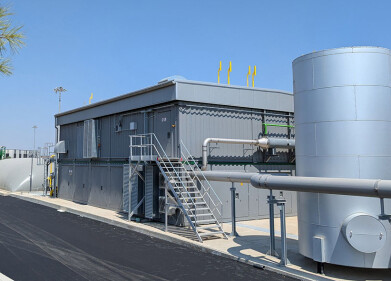Air clean up
Gas Cleaning Plant Helps Glass Producer Reduce China’s Carbon Footprint
Jul 28 2010
ACWA AIR’s (UK) third gas cleaning and energy recovery package is successfully helping the Chinese to reduce their carbon footprint.
The plant at Changshu on the Chinese eastern seaboard, operates a chemical vapour deposition (CVD) plant producing Pilkington’s Energy AdvantageTM low-e glass. This one glass plant, operated as a joint venture between China’s Shanghai Yaohua Pilkington Glass and the UK Pilkington Group Ltd will allow the Chinese to take 120,000 tonnes of carbon dioxide per year from their emissions by making their buildings more thermally efficient.
The Changshu plant is the third in a series of contracts awarded to ACWA AIR by NSG’s Pilkington Float Glass Business Group to prevent pollution from the CVD coating system and recover energy for use within the process.
The plant was designed in the UK by ACWA AIR and built as a series of modules in the UK, Europe and China before being assembled under ACWA AIR’s supervision, using local labour in China. Close co-operation between the British and Chinese engineers ensured that the plant was up and running some six weeks ahead of schedule.
The CVD plant emissions are significantly better than the Chinese limits on dust (40mg/Nm3 ), hydrogen chloride (30mg/Nm3 ) and hydrogen fluoride (3mg/Nm3 ) and the joint venture partners are considering the installation of a second production line.
THE PROCESS
The coating process uses complex organic tin salts and a mixture of other chemicals to generate the required surface on the float glass. The vent from the vapour coating process and associated chemical storage vessels is passed to a thermal oxidiser where the organic tin salts are broken down at high temperature into oxides of tin and hydrogen chloride gas.
Hot gases are discharged from the thermal oxidiser and 75% of the available heat energy is recovered in a boiler, generating steam, which is used for process heating in the CVD system. Any surplus steam is passed to an air-cooled condenser and the condensate is returned to the boiler.
The cooled flue gases, containing hydrogen chloride and hydrogen fluoride, are reacted with sodium bicarbonate, injected into the gas stream from a storage facility, producing sodium halide salts and carbon dioxide. The reaction rates with sodium bicarbonate are extremely fast and completely transform the corrosive gases into innocuous salts.
Solids suspended in the flue gases – a mixture of sodium halide salts, excess sodium bicarbonate and metal oxides – are filtered from the process by a pulse-jet bag filter and discharged into sealed skips. These solids may be recycled to recover tin.
Cleaned gases are discharged to atmosphere through a free-standing chimney stack by an induced draught fan.
Events
Jul 15 2025 Brighton, UK
Jul 23 2025 Sydney, Australia
Aug 24 2025 Stockholm, Sweden and online
Aug 27 2025 Busan, South Korea
Sep 02 2025 Mexico City, Mexico














